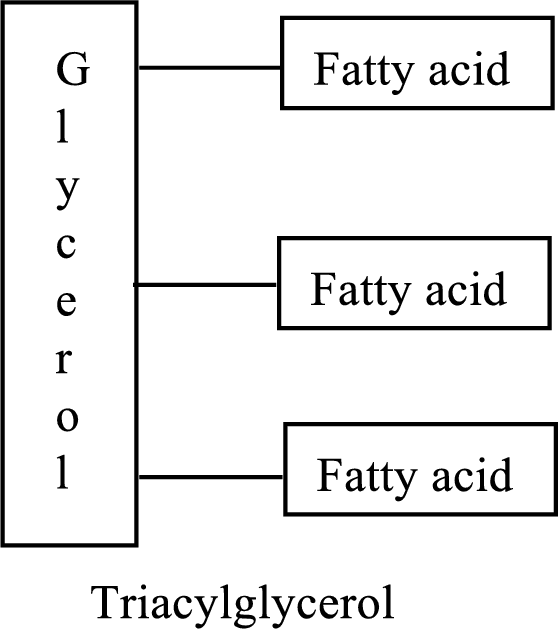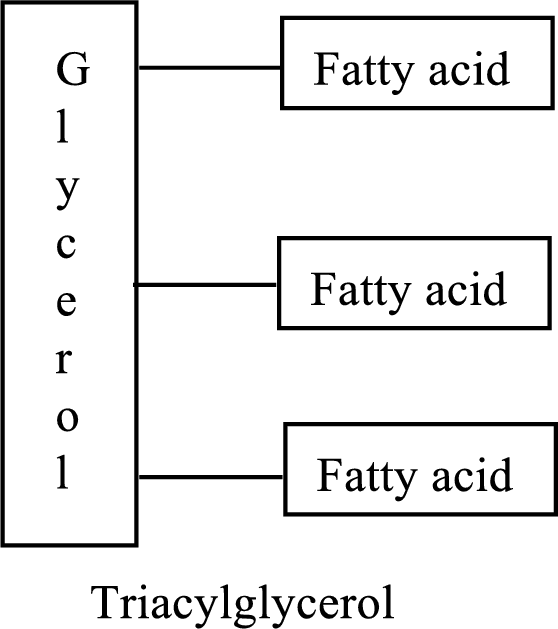
Concept explainers
(a)
Interpretation:
Whether the statement “about 50% of TAGs undergo complete hydrolysis in the stomach” concerning to triacylglycerol(TAG) digestion is true or false has to be determined.
Concept introduction:
Triacylglycerols are lipid molecules which constitute around 98% of the total dietary lipids. These lipid molecules undergo digestion/breakdown into simpler forms in the

(b)
Interpretation:
Whether the statement “cholecystokinin is the chemical name for bile” concerning to triacylglycerol(TAG) digestion is true or false has to be determined.
Concept introduction:
Triacylglycerols are lipid molecules which constitute around 98% of the total dietary lipids. These lipid molecules undergo digestion/breakdown into simpler forms in the digestive system and are later absorbed into the bloodstream. In the bloodstream, the hydrolysis products of triacylglycerols (fatty acids and glycerol) are absorbed by the body cells and are either broken down into acetyl CoA or stored as lipids for future use. Fats/Lipids are a richer source of energy compared to carbohydrates. While carbohydrates provide energy for immediate use, lipids provide energy for long term or future use. The structure of triacylglycerols is as follows:

(c)
Interpretation:
Whether the statement “most TAGs usually enter the small intestine in the form of monoacylglycerols” concerning to triacylglycerol(TAG) digestion is true or false has to be determined.
Concept introduction:
Triacylglycerols are lipid molecules which constitute around 98% of the total dietary lipids. These lipid molecules undergo digestion/breakdown into simpler forms in the digestive system and are later absorbed into the bloodstream. In the bloodstream, the hydrolysis products of triacylglycerols (fatty acids and glycerol) are absorbed by the body cells and are either broken down into acetyl CoA or stored as lipids for future use. Fats/Lipids are a richer source of energy compared to carbohydrates. While carbohydrates provide energy for immediate use, lipids provide energy for long term or future use. The structure of triacylglycerols is as follows:

(d)
Interpretation:
Whether the statement “chyme produced in the stomach settles to the bottom of the stomach” concerning to triacylglycerol(TAG) digestion is true or false has to be determined.
Concept introduction:
Triacylglycerols are lipid molecules which constitute around 98% of the total dietary lipids. These lipid molecules undergo digestion/breakdown into simpler forms in the digestive system and are later absorbed into the bloodstream. In the bloodstream, the hydrolysis products of triacylglycerols (fatty acids and glycerol) are absorbed by the body cells and are either broken down into acetyl CoA or stored as lipids for future use. Fats/Lipids are a richer source of energy compared to carbohydrates. While carbohydrates provide energy for immediate use, lipids provide energy for long term or future use.
The structure of triacylglycerols is as follows:

Want to see the full answer?
Check out a sample textbook solution
Chapter 14 Solutions
Organic And Biological Chemistry
 General, Organic, and Biological ChemistryChemistryISBN:9781285853918Author:H. Stephen StokerPublisher:Cengage Learning
General, Organic, and Biological ChemistryChemistryISBN:9781285853918Author:H. Stephen StokerPublisher:Cengage Learning Organic And Biological ChemistryChemistryISBN:9781305081079Author:STOKER, H. Stephen (howard Stephen)Publisher:Cengage Learning,
Organic And Biological ChemistryChemistryISBN:9781305081079Author:STOKER, H. Stephen (howard Stephen)Publisher:Cengage Learning, Chemistry for Today: General, Organic, and Bioche...ChemistryISBN:9781305960060Author:Spencer L. Seager, Michael R. Slabaugh, Maren S. HansenPublisher:Cengage Learning
Chemistry for Today: General, Organic, and Bioche...ChemistryISBN:9781305960060Author:Spencer L. Seager, Michael R. Slabaugh, Maren S. HansenPublisher:Cengage Learning Introduction to General, Organic and BiochemistryChemistryISBN:9781285869759Author:Frederick A. Bettelheim, William H. Brown, Mary K. Campbell, Shawn O. Farrell, Omar TorresPublisher:Cengage LearningChemistry: Matter and ChangeChemistryISBN:9780078746376Author:Dinah Zike, Laurel Dingrando, Nicholas Hainen, Cheryl WistromPublisher:Glencoe/McGraw-Hill School Pub Co
Introduction to General, Organic and BiochemistryChemistryISBN:9781285869759Author:Frederick A. Bettelheim, William H. Brown, Mary K. Campbell, Shawn O. Farrell, Omar TorresPublisher:Cengage LearningChemistry: Matter and ChangeChemistryISBN:9780078746376Author:Dinah Zike, Laurel Dingrando, Nicholas Hainen, Cheryl WistromPublisher:Glencoe/McGraw-Hill School Pub Co




